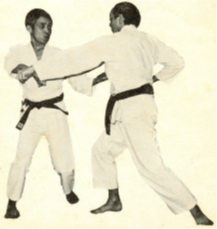Nippon Kempo, a losse method…
Many of you are wondering where the elders got the strange Kumites where, with unusual freedom and at unusually short distance, they hit, parent and dodge in an unorthodox way.
You sometimes hear the older ones talking nostalgically about Kumites that we practised under the direction of the Master already twenty years ago, without anyone really knowing where they came from.
This little booklet is therefore a bit of our history…
Download this book hereafter…
Sanchin Kata
The Karate of the Wado-Ryu school is in fact quite simple and limited: the basic movements (the Kihon), nine Katas (the five Pinan, Kushanku, Naihanchi, Seishan and Chinto Katas), the Kihon Kumites (and the Yakusoku Kumites which prepare them, if necessary).
For Master Ohtsuka, (Founder of Wado Ryu) these movements were more than enough to understand the essential.
For us, people from the West, the reasons why Master Ohtsuka limited himself to these few movements, are often incomprehensible; it is therefore necessary to seek other means to make people understand what it is all about.
For example, the movement of Kote-Uke or Shuto-Uke are difficult to understand without any other explanation; in order to do so, it would be necessary to know the Seishan kata, the essence of which escapes those who are not familiar with the world of Pinan and Kushanku…
Kihon-Kumite Wado-Ryu

| Kihon-Kumite No. 1 – ipponme presentation. description. | Kihon-Kumite No. 2 – nihonme Presentation. Description. |
| Kihon-Kumite No. 3 – sanbonme presentation. description. | Kihon-Kumite No. 4 – yonhonme presentation. description. |
| Kihon-Kumite No. 5 – gohonme presentation. description. | Kihon-Kumite No. 6 – ropponme Presentation. Description. |
| Kihon-Kumite No. 7 – nanahonme presentation. description. | Kihon-Kumite No. 8 – hachihonme presentation. description. |
| Kihon-Kumite No. 9 – kyuhonme Presentation. Description. | Kihon-Kumite No. 1O – jipponme presentation. description. |
Overview of the Kihon-Kumites
The Kihon Kumites were developed by Master Ohtsuka. It is said that the one who masters them perfectly is invincible. Master Ohtsuka was first and foremost a practitioner of Jû-jitsu. At the end of his life he was said to have returned to his first love; he said to himself
Jû-Jitsuka and not Karateka.
The text you will read, was published in Japan on the occasion of a world championship of the Wadô-Ryû school, and reviewed on the basis of the text of Master Ohtsuka; neither text was written by the founder (there is none to my knowledge); it is therefore quite possible that these descriptions do not reflect his way of doing things, but for lack of thrushes, it will be necessary to settle for robin …
A few remarks before you start
These Kihon-Kumites are – with one exception – Nihon Kumites, i.e. Kumites where two exchanges of blows take place, at different levels.
You will recognize a OMOTE version and an URA version of each situation.
Forms are of great importance, both in attitudes and movements.
You might feel like these Kumites are easy, but it’s only after many years that you understand the depth and finesse; so don’t believe too fast that you’ve gone around.
Some attitudes lend themselves particularly badly to defensive or attacking movements (e.g. the attitude of Shiko-Dachi to make Kaishin, in the No. 1). Despite this it is necessary to focus on making the body movement with great care and attention to detail.
More than anywhere else it is impossible to reduce the movements of Kihon-Kumites to usual techniques (such as Kote Uke, Gedan-Baraï, Jôdan-Age-Uke…): these Kumites are not assemblages of known movements.
This can only be prepared indirectly by deepening other forms of exercise.
Parades never break the blow but embrace the movement of the body that dodges in different directions.
The free forearm is in front of the trunk and not pulled to the side (Hikite) as in the Kihon.
Dodges, simple at first glance, are actually very subtle; for example, the Kaishin movement often mixes one or more other dodge movements such as Sorimi or Hikirni.
From the beginning you must try to clear the barrier that separates you from the opponent and to embrace his intentions.
It is in this way that one can make a whole with him and let a harmony or a kind of connivance be established between him and oneself; in short, you have to try to put yourself on the same wavelength as him.
Thus the two opponents face each other and greet each other at the beginning of the series of Kumites, react to the slightest movement of the other, begin to move at the same time, separate together, and return together to their original location.
The Yaku-Soku-Kumites are a valuable preparation and explanation to the Kihon -Kumites; they are sometimes very similar. It is therefore better to have a solid experience before risking to practice Kihon-Kumites….
